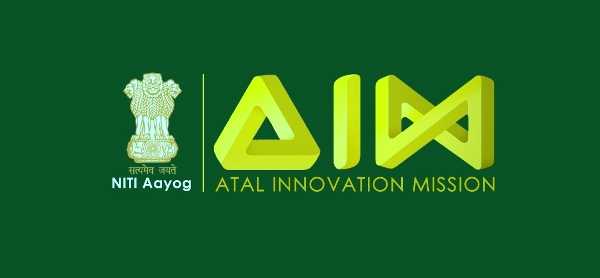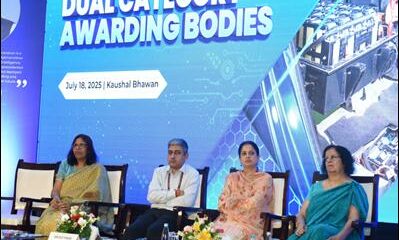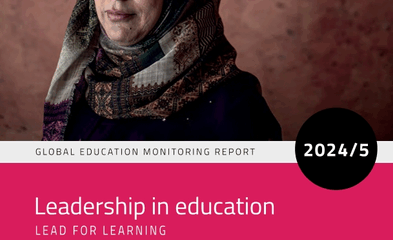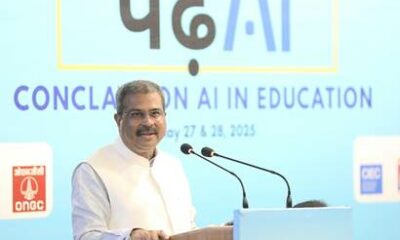Knowledge
UNESCO Launches 2020 State of the Education Report for India: Vocational Education First
The second edition of the State of Education Report focuses on technical and vocational education and training (TVET).
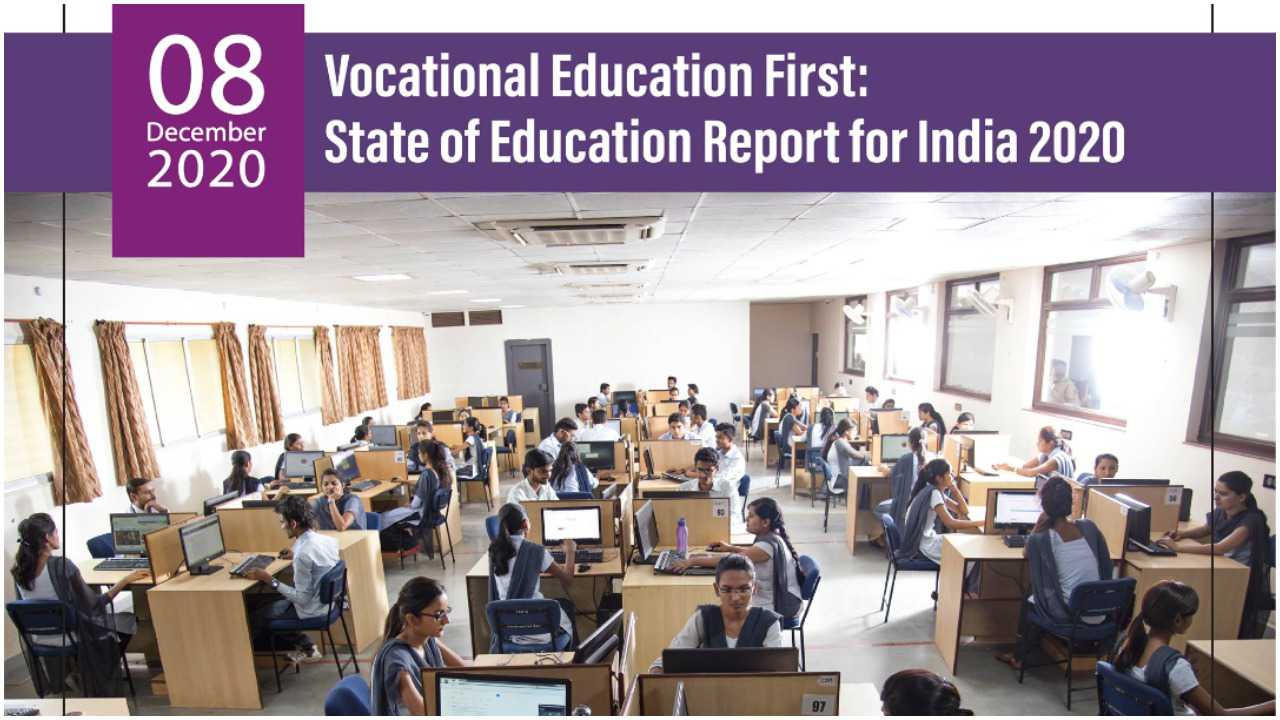
New Delhi, 3 December: The ‘State of the Education Report for India 2020: Technical and Vocational Education and Training (TVET) ’ was launched virtually today by UNESCO New Delhi, with over 400 attendees, including representatives from the government, civil society, academia, partners and youth.
The second edition of the State of Education Report focuses on technical and vocational education and training (TVET). India's often cited demographic dividend, the aspirations of its youth and the skill requirements of the growing economy – all hinge on a well-functioning TVET system for achieving an inclusive and equitable growth that will propel the country to the next phase of socio-economic development. The report aims to support the Government of India which has already announced skills development as a key national priority under the Skill India Mission.
“The Report identifies TVET as a key tool for recovery and rehabilitation through a rapid response system of skilling, upskilling and re-skilling. Despite the challenges, the global COVID-19 pandemic has provided an opportunity to expand the digitalization of vocational education and training ensuring the use of distance learning and digital tools”, said Eric Falt, UNESCO New Delhi Director.
“With the recent launch of the National Education Policy (NEP) 2020, the relevance of this report is enhanced further as it provides useful inputs for implementing the ideas proposed in the 2020 NEP. I hope this publication will enable cross-learning among the multiple stakeholders of the vast vocational education ecosystem and adoption of best practices,” said Shri Ramesh Pokhriyal ‘Nishank’, Hon’ble Minister of Education, Government of India.
“Our Ministry is making continuous efforts to enable social justice and livelihoods through quality lifelong learning opportunities for all. This report, I am sure will provide useful guidance and promising practices towards our endeavour and ongoing efforts towards the achievement of the Skill India mission”, said Shri Mahendra Nath Pandey, Hon’ble Minister of Skill Development and Entrepreneurship, Government of India.
As a technical and financial partner to UNESCO’s TVET State of the Education Report 2020, the American India Foundation aims to build upon its strong legacy of education and livelihood programmes for India’s youth and women, through remote learning and virtual skilling methods, thereby aligning with the National Education Policy 2020. A rapidly evolving employment landscape, brought on by the COVID-19 pandemic, has necessitated that skilling is reoriented towards the needs of the hour”, said Mathew Joseph, AIF’s India Country Director.
With an in-depth analysis of the current state of TVET in India highlighting next practices and recommendations, the report aims to serve as a reference tool for enhancing and influencing the policies and programs related to skills development in India. It can be used by TVET practitioners, policymakers, private sector and donor agencies for planning future engagements in the TVET sector in India.
India is at an exciting stage today, having made considerable progress towards its goal of creating a skilled workforce of 110 million people by 2022, as stated in the National Policy of Skill Development and Entrepreneurship (NPSDE), released in 2015 [NPSDE 2015]. It is presently training 10 million1 youth annually through the many schemes that are ongoing.
The Report provides an overview of the present capacity for TVET provision through short-term and long-term courses, by the state as well as non-state actors, and also through educational institutions such as schools, colleges and universities. It discusses previous education policies and the approach to TVET provision in the light of the priorities of the country as reflected in NEP 2020, as also the priorities that have come with the adoption of the 2030 Agenda for Sustainable Development of the United Nations (UN).
Finally, in order to achieve evidence-based results, the Report outlines a set of ten recommendations that should be adopted to help achieve the stated vision for TVET in the country. These include critical recommendations for informal workers who make up the largest portion of India’s workforce. In particular, the Report makes important recommendations towards preserving and promoting India’s vast reserves of tangible and intangible cultural heritage, an activity that can create livelihoods for large numbers of its citizens and also instil a sense of pride and ownership among the youth.
The ten recommendations are:
· Place learners and their aspirations at the centre of vocational education and training programmes
· Create an appropriate ecosystem for teachers, trainers and assessors
· Focus on upskilling, re-skilling and lifelong learning
· Ensure inclusive access to TVET for women, differently-abled and disadvantaged learners
· Massively expand the digitalization of vocational education and training
· Support local communities to generate livelihoods by engaging in the preservation of tangible and intangible cultural heritage
· Align better with the 2030 Agenda for Sustainable Development
· Deploy innovative models of financing TVET
· Expand evidence-based research for better planning and monitoring
· Establish a robust coordinating mechanism for inter-ministerial cooperation
The substance of the Report has been developed by an experienced team of researchers from the Tata Institute of Social Sciences, Mumbai, under the guidance of UNESCO New Delhi. The technical and financial partner — American India Foundation (AIF), is a leading not-for-profit organization committed to improving the lives of India’s underprivileged, with a special focus on women, children, and youth.
As part of the launch, the media will have access to the following audio-visual products that include:
- Summary video – Underlining the 10 recommendations of the Report
- Experiences of a vocational education trainee – Arvind Kumar a trainee at Learnet Delhi shares his aspirations after pursuing a welding technician course
- Experiences of a vocational education trainer – Bhanupriya a vocational trainer shares her motivating experience of empowering lives in short duration
- Over 50 high-quality images free of copyright (available on request)
Note to the Editors:
The State of the Education Report for India is one of UNESCO New Delhi’s flagship reports to be published annually. Its main objective will be to monitor progress towards the education targets in the Sustainable Development Goals (SDGs).
UNESCO has developed a Strategy for TVET (2016-2021) in alignment with Sustainable Development Goal 4 and the Education 2030 Framework for Action to strengthen TVET systems of Member States and advance youth employment, access to decent work, entrepreneurship and lifelong learning opportunities in specific national contexts.
The TVET Strategy for 2016 – 2021 has three priority areas:
· Fostering youth employment and entrepreneurship
· Promoting equity and gender equality
· Facilitating the transition to green economies and sustainable societies
About UNESCO:
UNESCO is the United Nations Educational, Scientific and Cultural Organization. It seeks to build peace through international cooperation in Education, the Sciences and Culture. UNESCO's programmes contribute to the achievement of the Sustainable Development Goals defined in Agenda 2030, adopted by the UN General Assembly in 2015.
In this spirit, UNESCO develops educational tools to help people live as global citizens free of hate and intolerance. UNESCO works so that each child and citizen has access to quality education. By promoting cultural heritage and the equal dignity of all cultures, UNESCO strengthens bonds among nations. UNESCO fosters scientific programmes and policies as platforms for development and cooperation. UNESCO stands up for freedom of expression, as a fundamental right and a key condition for democracy and development. Serving as a laboratory of ideas, UNESCO helps countries adopt international standards and manages programmes that foster the free flow of ideas and knowledge sharing.
Education
How to Build Better Parent-Teacher Communication

Good communication between parents and teachers plays an important role in a child’s learning and confidence. When both stay connected, it helps students feel encouraged and understood. Still, it’s not always easy to keep that connection strong. Busy schedules and small misunderstandings can make things tricky. The good news is that a few simple habits can make a real difference. Let’s examine what parent-teacher communication truly entails and how both parties can collaborate more effectively.
What is Teacher and Parent Communication?
Teacher and parent communication is all about staying connected and working together for a child’s growth. It’s not just a one-time meeting or message but a continuous, two-way exchange of updates, ideas, and feedback. When teachers and families stay in touch regularly, it creates a strong support system that helps students do better both in and outside the classroom.
In simple terms, teachers share what’s happening at school, like:
- Homework and assignments
- Grades and test results
- Class activities and behavior updates
- Social and emotional progress
- Strengths and areas where a student might need extra help
At the same time, parents share what’s happening at home, such as:
- How the child feels about schoolwork
- Any challenges or changes they’ve noticed
- Questions or suggestions about learning support
When both sides keep the communication open, it builds trust and teamwork. Teachers understand students better, and parents feel more involved in their child’s education.
Tips for Smooth Parent-Teacher Communication
Talking to parents doesn’t have to feel formal or uncomfortable. In fact, the better your connection with them, the smoother your teaching journey becomes. Whether you’re reaching out for the first time or trying to keep the conversation going, here are some real-world ways to build trust and keep communication easy, clear, and helpful.
1. Begin with a Friendly Introduction
Right at the beginning of the academic year, take a moment to introduce yourself to parents. You can send a friendly email, a printed note, or even a short video message. Let them know who you are, what you’re excited about, and how they can reach you. This early step breaks the ice and helps parents feel welcome and included in their child’s learning journey. When you set a positive tone early, it makes future communication easier and more comfortable for everyone.
2. Communicate Often, Not Just When There’s a Problem
Don’t let communication only happen during parent-teacher conferences or when something goes wrong. Send regular updates about what’s happening in class, upcoming events, or even small successes their child has had during the week. These don’t need to be long messages. A quick note about a student’s progress or behavior can make a parent’s day and help build trust over time. It also shows that you’re not just reaching out when there’s a problem.
3. Invite Their Voice, Too
Sometimes we forget that parents know their child better than anyone else. Ask questions. How does their child learn best at home? Are there any routines or challenges you should know about? And when they speak, listen fully. These conversations often reveal things that can shape how you teach and connect with the student.
4. Be Available and Approachable
Parents need to know that they can come to you when something is on their mind. That doesn’t mean being available 24/7, but it does mean creating space for honest conversations. You can let them know about your preferred times for calls or meetings, and also offer virtual options if in-person isn’t possible. Make sure the tone of your communication is always warm and non-judgmental so they feel safe speaking up.
5. Treat Parents as Team Members, Not Outsiders
Instead of just delivering information, try to involve parents as partners in their child’s learning. Share ideas for how they can help at home, ask for their observations, and thank them for their efforts. If there’s a behaviour issue or academic challenge, work with them on solutions instead of just reporting the problem. A strong home-school partnership creates a consistent support system for the student, both inside and outside the classroom.
6. Show Cultural Awareness and Respect
Families come from many different backgrounds, and their expectations may vary. Take the time to learn about their culture, language preferences, and family structure. Avoid making assumptions or using language that might feel exclusive. If needed, provide translations or simplify your communication to make sure everyone understands. This small effort shows parents that you value who they are and where they come from.
7. Share Progress in a Way That’s Clear and Supportive
Progress updates should be balanced. Yes, it’s important to point out what’s not working, but don’t forget to highlight what is. Give specific examples instead of vague praise or criticism. Say things like, “I’ve noticed Priya really lights up during science experiments,” or “Rohan is still working on staying focused during group tasks.” This kind of feedback feels personal and helps parents understand the full picture.
8. Choose the Right Tools for the Right Message
Too many apps or tools can overwhelm parents quickly. Choose one or two that you’ll stick to, whether it’s a school app, WhatsApp group, or weekly email. Use them for quick updates, reminders, or sharing student wins. Keep your tone casual but clear. Tech is helpful only when it makes life easier for both sides.
9. Respect Their Time and Yours
Teachers and parents are both juggling busy schedules. Respecting each other’s time helps keep communication productive and stress-free. If you’re scheduling meetings, offer time slots that work for working parents, too. Keep conversations focused so that meetings don’t run longer than necessary. Also, set clear boundaries about when you’re available.
When Is Parent-Teacher Communication Most Important?
Parent-teacher communication matters most right at the start of preschool. That first day of preschool is a big moment for every child and their family. When teachers and parents talk openly from day one, it helps everyone feel more comfortable and sets up a strong partnership for the rest of the year.
Why It Matters on Day One
- The first day of preschool often brings a mix of excitement and nervousness for both kids and parents. Honest communication helps everyone feel a little more comfortable.
- Open communication lets teachers learn about each child’s background, interests, and any worries or comforts. This way, teachers can give more personalized care and support from the beginning.
- Early conversations help build a sense of trust between home and school, making the classroom feel like a safe and welcoming place for the child.
- When teachers share classroom routines and expectations with parents on the first day, it helps families get ready and feel involved in their child’s new experience.
- These early talks also give teachers helpful details, like which languages are spoken at home, special family traditions, or any recent changes in the child’s life. This helps teachers communicate better and offer the right kind of support.
By making communication a priority from the very first day, both teachers and parents can work together to help each child settle in smoothly and feel confident as they start their schooling journey. Building strong parent-teacher teamwork not only supports a child’s emotional well-being but also lays the foundation for long-term academic success.
Closing Thoughts
We hope these tips help make your conversations with parents smoother and more meaningful. Building that connection takes time, but small efforts can lead to strong partnerships.
This article is authored by-
Chitra Khanna,
Content Strategist,
KLAY Preschools & Daycare
Education
Empowering Young People to Champion Neuro-Inclusion
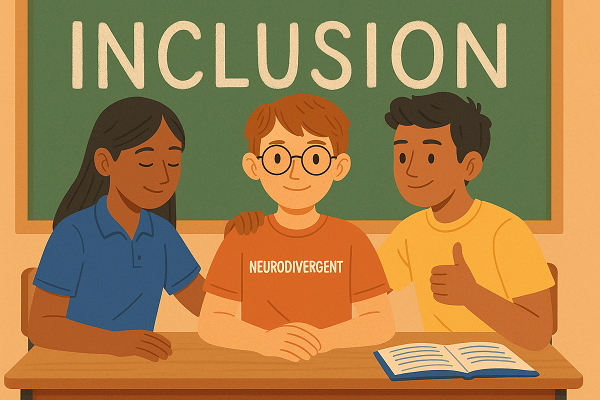
Aamir Khan’s recent film Sitaare Zameen Par has brought neurodiversity into the mainstream, and sparked important conversations about inclusion and rethinking what we consider ‘normal’. These cultural moments help raise awareness, but they also remind us that there is still a long way to go in making inclusion a lived reality.
It is estimated that 1 in 8 children in India have a neurodevelopmental condition such as ADHD, autism, learning disabilities and intellectual disability. Many of these children often face social isolation, bullying and exclusion – often the earliest of these experiences begin during school.
At the same time, today’s young people indeed carry with them a deep sense of social justice and openness to diversity. The energy, empathy and bold creativity of young people can be harnessed – if nurtured in the right way, at the right time – to make them equal partners in cultivating inclusive cultures in schools and communities.
We need young allies – people who are not only informed, but who engage meaningfully with neurodivergent peers, actively support the cause, and drive inclusivity. The key lies in equipping them with the knowledge, skills, and ultimately the mindset needed for inclusion. Schools must invest in nurturing young allies who can champion neurodiversity and take ownership of inclusion in spaces they belong to.
Our experience and work on youth allyship has shaped our understanding of what it takes to make this happen. Here are some of our most important insights:
- From awareness to active allyship: We need to move beyond awareness about neurodiversity, by equipping students with the knowledge, skills, confidence, and opportunities to take meaningful action as allies for neuro-inclusion.
- A personalised journey: Allyship is a lifelong journey which is most authentic when it grows organically from curiosity, dialogue, self-initiative and experiences. It cannot be imposed, and must be led by the individual.
- Student autonomy: When students have the autonomy to choose how they contribute, their commitment deepens. We should give students a mix of structure and freedom to help – guidance to shape their efforts, alongside the space to decide how they want to step up for meaningful change.
So how can schools nurture students as young allies?
- Create safe, relatable spaces led by students, for students Peer-led conversations give students space to reflect on diversity, challenge stereotypes, and share personal experiences. When peers lead, the power dynamics shift – students listen more openly, express without fear of judgment, and begin to see inclusion as something that belongs to them, not just a directive from authority figures. Our Inclusive Duniya Circles are one example of such spaces. Students are primed and empowered to sensitively facilitate conversations about disability, neurodiversity and inclusion.
- Explore connections to students’ interests and strengths
Students should be given the opportunity to discover how they feel about the cause and how they want to contribute. At the end of each Circle, we often ask, “How do you want to step up for an Inclusive Duniya?” The answers vary, but what matters most is that the initiative comes from the students themselves. Our role as adults and educators is to support them in making it happen.
Some take the route of advocacy – sparking conversations and campaigning for the cause with schoolmates. Others channel creativity through music, art, or theatre that challenges stereotypes.
For instance, the song Inclusive Duniya (available on Spotify), was written, composed and produced by students on their own from carefully crafting lyrics which invited listeners to imagine a world where everyone feels like they belong to picking melodies that convey warmth. Students used their creative talents to make a gentle but compelling call to action for allyship. Helping students tap into their personal strengths and interests enables authentic engagement and contribution to the cause.
- Embed into academic and co-curricular pathways
Linking students’ inclusion initiatives and projects to existing academic opportunities, such as CAS projects in the IB curriculum, allows them to merge personal passion with academic commitment. Framing these initiatives as co-curricular activities also strengthens students’ profiles for college applications. This dual recognition provides a formal recognition to their efforts and ensures students’ efforts are sustained – adding motivation, depth and commitment to their efforts.
The voices of young people not only impact their peers, but also have a ripple effect in shaping how families talk about disabilities, and, in due course, how communities and workplaces open themselves up to inclusion.
With the right support, our young generation can become a driving force for an inclusive world. Schools, as microcosms of society, provide the most conducive space for young people to explore sensitive concepts, question biases, and practice inclusion in meaningful ways. By nurturing young allies who truly value and celebrate diverse ways of thinking and being, we can lay the foundation for a more Inclusive Duniya.
This article is co-authored by:

Pooja Sharma, Founder and CEO, Inclusive Duniya

Srushti Patel, Manager- Schools Programme, Inclusive Duniya
Education
Supreme Court Calls for Early Sex Education in Schools: “Not from Class IX, But from a Younger Age”

In a landmark observation, the Supreme Court of India has emphasised the urgent need to introduce sex education at a younger age, rather than waiting until Class IX as is the current norm. The apex court stated that children should be informed and sensitised about the physical and emotional changes that accompany puberty — and taught the necessary care and caution that come with it.
The observation came from a Bench comprising Justice Sanjay Kumar and Justice Alok Aradhe, which noted that the absence of early sex education leaves children vulnerable to misinformation and misunderstanding during their formative years.
“Sex education should be provided to children from a younger age and not Class IX onwards. It is for the authorities concerned to apply their mind and take corrective measures so that children are informed of the changes that happen after puberty,” the court stated.
The Bench made the remarks while hearing an appeal filed by a 15-year-old boy, who had been denied bail by the Allahabad High Court in a case under Sections 376 and 506 of the Indian Penal Code (IPC) and Section 6 of the Protection of Children from Sexual Offences (POCSO) Act. Recognising that the accused was himself a minor, the Supreme Court had earlier granted him bail in September 2025.
In the same case, the Court had directed the Government of Uttar Pradesh to submit an affidavit explaining how sex education is currently implemented in schools. The state responded that sex education is introduced only in Classes IX to XII, following NCERT guidelines. However, the Bench expressed concern over this delayed introduction and urged policymakers to revisit the framework to ensure children receive age-appropriate education much earlier.
The Court set aside the High Court’s order and made the juvenile’s bail permanent until the completion of the trial. More importantly, its remarks have reignited the national debate on the need for comprehensive sexuality education in India, which many experts argue is crucial to preventing abuse, reducing stigma, and promoting healthy development among adolescents.
Education experts have long maintained that early, factual, and inclusive discussions about puberty, consent, and emotional health must begin before adolescence — ideally in primary school — to prepare children for real-world experiences and relationships. The Supreme Court’s observation is expected to prompt renewed policy discussions on revising the sex education curriculum nationwide.
Education
India Loves its Teachers, Just Not Enough to Pay Them: India Today Reports
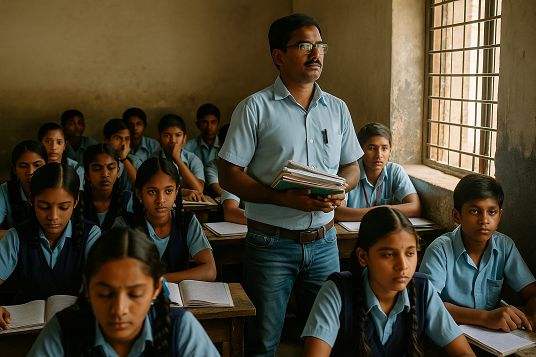
A recent report by India Today has put the spotlight on the deep contradictions in how India treats its teachers. While the profession is revered in public discourse and celebrated in ceremonies, the reality of poor pay, massive vacancies, and crushing workloads threatens the future of quality education in the country.
The report, authored by Megha Chaturvedi, shares the story of a government school teacher in rural Bihar who manages five grades, multiple subjects, administrative duties, and a long commute — all for a monthly pay of just ₹12,000. It is a picture that repeats across India, where respect is high but reward is missing.
Respect vs Pay
According to UDISE+ 2024–25 data, India’s teaching workforce has crossed 1 crore, with women making up 54.2%. Yet, over 1 million teaching posts remain vacant, concentrated in states like Uttar Pradesh (3.2 lakh) and Bihar (2.2 lakh). More than 1 lakh schools still run with just a single teacher, and some rural institutions report zero enrolment.
Teacher salaries are shockingly unequal. Permanent government teachers may earn ₹35,000 to ₹60,000 per month with benefits, but guest or contractual teachers often earn between ₹6,500 and ₹12,500, with delays stretching into months. Even in metro private schools, where parents pay lakhs in annual fees, teachers may take home just 2–10% of that amount.
International comparisons highlight the gap further. India ranks among the top 10 nations for respect towards teachers, yet falls to the bottom when it comes to pay and working conditions.
The Consequences
Low pay and insecure contracts drive talented graduates away from teaching. Those who stay face burnout from handling multiple grades or excessive administrative duties. Morale suffers when salaries are delayed, creating inequality between well-paid urban private school teachers and struggling rural counterparts. The result is a two-tiered system where students’ learning is directly compromised.
Policy Moves
Some states have taken steps. Karnataka recently raised guest teacher pay to ₹12,000–₹12,500, though teachers demand at least ₹30,000. Bihar and West Bengal have launched recruitment drives to fill thousands of vacancies. But reforms remain piecemeal. The India Today report makes it clear that modest hikes are not enough to match workload or cost of living, and insecurity continues to define contractual positions.
What Needs to Change
India may call its teachers “gurus” but without dignified salaries, stability, and recognition, the profession risks becoming even less attractive to young graduates. For education to thrive, teaching must be seen as a rewarding and respected career. ScooNews has been consistently working to spotlight teacher voices and celebrate educators who innovate against the odds. Yet change cannot come from media or policy alone. We need educators themselves to step up and demand better, and institutions to stop treating education as a business rather than a public service.
A practical way forward would include setting a national minimum pay scale of at least ₹30,000 per month for all full-time teachers, clearing the backlog of 1 million vacancies within the next three years, and ensuring strict timelines for salary disbursement. Governments and boards must invest at least 6% of GDP into education as repeatedly recommended, with a clear allocation for teacher training, well-being, and incentives. Schools must commit a fixed percentage of fee revenue directly to teacher salaries, while also offering pathways for career growth through research, leadership roles, and international exposure.
Teaching is perhaps the most undervalued profession in the nation today. If India is to build a future-ready generation, it must invest in its teachers with the same seriousness it reserves for infrastructure or defence. Respect in words is not enough. Teachers must be valued in pay, dignity, and opportunity.
You can read the full report here.
Education
UK and US Tighten Student Visas: What Indian Schools and Students Must Know

The tightening of student visa policies in the US and UK has created understandable anxiety among Indian families.
In the UK, the Graduate Route visa may be reduced from two years to 18 months for undergraduates and master’s graduates, while doctoral students may keep three years. Most taught master’s students can no longer bring dependents, the country has raised proof of funds by over 11%, moved to digital e-visas and tightened university compliance.
The US has proposed limiting the F-1 visa to a fixed four-year term, requiring extensions for longer programmes such as PhDs. Interview waivers have been eliminated, and third-country applications are no longer permitted. Backlogs at Indian consulates have worsened, and a new $250 Visa Integrity Fee will soon add to costs.
While complex, these changes reflect a global trend: governments are balancing immigration management with continued student flows. For Indian applicants, this means approaching the process with a sharper focus and stronger preparation.
What these changes mean for Indian students
The proposed cut of the Graduate Route visa to 18 months may cause concern, but this timeframe is enough to build career foundations, especially for students who engage early with employers. Restrictions on dependants may deter older applicants, but younger students will still find the UK attractive. The move to digital e-visas actually simplifies the verification process, while higher proof of funds requirements will require earlier financial planning. Additionally, English language changes should not affect Indian applicants, who already meet or exceed the required standards.
In the US, the proposed four-year F-1 limit introduces uncertainty for PhD students; yet, the country still offers unmatched academic choices, world-class research opportunities, and globally valued degrees. The loss of interview waivers, the ban on third-country applications and the new fee add costs and delays, but with early planning and budgeting, these hurdles are manageable. For many families, the academic ecosystem, extensive networks and long-term career benefits of a US education outweigh the administrative challenges.
How admissions counsellors and schools can guide students
Schools and counsellors now have a greater responsibility. Planning must begin early, whether preparing for tests, selecting courses or booking visa appointments, so backlogs and rule changes cause less disruption. Financial planning is equally critical, as higher UK proof of funds and new US fees make it essential to understand costs well in advance. Counsellors should also help students think long term, making strategic academic and career choices while exploring alternatives beyond the US and UK. With preparation and broad awareness, families can navigate uncertainty without losing sight of their goals.
Looking beyond the US and UK
These changes should not deter Indian families from considering the US or UK. Both remain prestigious destinations with world-class academic ecosystems. At the same time, I encourage families to keep alternatives in mind. Canada, Ireland, Australia and parts of Europe offer attractive post-study work options, while Singapore, Japan and the UAE are emerging as strong contenders closer to home.
In fact, at The Red Pen, pre-COVID, we saw families looking at an average of two destinations. This has now moved to 3.2. Keeping options open is a good idea.
Students can also explore new-age Indian universities such as Ashoka, Krea, Plaksha, FLAME and Jindal, which offer programmes on par with international standards. In addition, 12 global universities are opening campuses in India. While Deakin University, Wollongong University and the University of Southampton are already established, new entrants from 2026 include the Illinois Institute of Technology, University of Liverpool, Queen’s University Belfast, Coventry University, University of York, University of Western Australia, University of Aberdeen, Istituto Europeo di Design and Western Sydney University.
While tighter visa rules demand careful planning, expert guidance ensures that international education remains firmly within reach.
This article is authored by-

Namita Mehta- President and Partner, The Red Pen
Namita drives business growth and global partnerships at The Red Pen, representing the firm at international education forums and building key alliances, including a landmark collaboration with U.S. News & World Report. Recognised among BW Education’s 40 Under 40 and The PIE’s 50 Voices in Leadership, she has twice been shortlisted for the HerRising Awards. Namita has judged the PIE Education Awards, spoken at HSBC, Ashoka University, IC3 and Master’s Union, and contributed to leading publications such as Economic Times, Mint, Hindustan Times and The PIE News. She also serves on the advisory board of The Outreach Collective.
Education
International Literacy Day 2025: Beyond Reading and Writing in the Digital Era
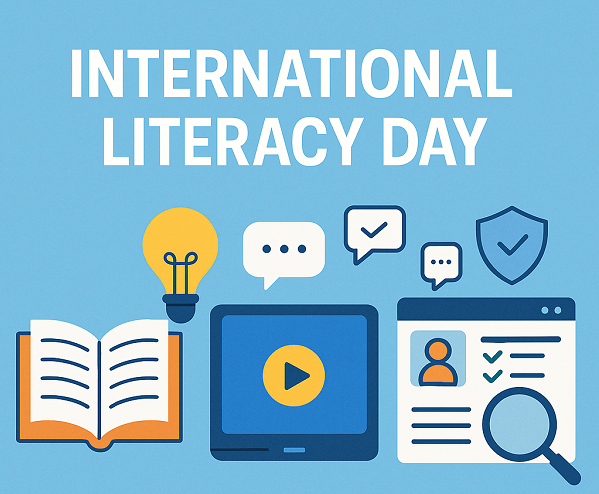
“Education is not only the birthright of every human being but also the weapon of social change.”
Dr B. R. Ambedkar’s words carry even more weight today as we celebrate International Literacy Day 2025. This year’s theme, “Promoting literacy in the digital era,” reminds us that literacy no longer begins and ends with pen and paper.
A Journey Worth Remembering
India’s literacy story is one of resilience. In 1951, only 16 out of every 100 Indians could read and write. By 2022, that number had climbed to 77.7 per cent. The Right to Education Act of 2009 opened the doors of schools to millions who might otherwise have been left behind. Yet numbers alone do not tell the full story. Getting children into classrooms was only the first battle. The bigger challenge lies in what and how they learn.
Literacy in the Age of Screens
In a world where screens dominate, literacy now means much more than decoding text. It is about being able to access, understand, evaluate, and create digital content in safe and responsible ways. A teenager scrolling endlessly on social media might look “digitally literate,” but true literacy asks whether that teenager can spot a fake news story, respond appropriately to cyberbullying, or understand that their digital footprint will outlive their mood.
The dangers are real. A BBC feature this year explained how adolescence itself makes young people more vulnerable to online manipulation because their brains are wired for risk-taking and peer approval. Platforms exploit these vulnerabilities with algorithms that feed them echo chambers of extreme views and endless scrolling loops. What looks like harmless entertainment often becomes a powerful shaper of values and identities.
At the same time, teenagers are seeking comfort in unexpected places. An ETV Bharat report revealed that many Indian students now turn to AI chatbots for emotional support. Experts worry that without proper guidance, children may start to trust technology more than people, with little understanding of how these systems work or what agendas they may carry. Digital literacy, therefore, is not simply about knowing how to use a device but about learning how to navigate relationships, trust, and choices in a digital-first world.
The Missing Lessons
Alongside digital literacy, we are also missing some of the most practical lessons of life. An India Today feature pointed out that while our students can solve complex equations, very few know how to calculate tax, understand savings, or even read the fine print of a bank loan. In an age of instant loans and digital payment apps, this lack of financial literacy is dangerous. Children should be learning how to protect themselves from online scams, how to recognise manipulative advertisements, and how to make decisions that safeguard their futures.
The truth is, literacy today is incomplete without responsibility. Children may be skilled at clicking, posting, or streaming, but if they do not know what to believe, what to share, and what to ignore, they are vulnerable. Civic sense must become part of the digital literacy package. How we behave online is not separate from who we are as citizens. Words can wound, misinformation can destabilise, and silence in the face of bullying can be as harmful as participation.
For India to truly lead in the digital era, we must expand our vision of education. That means increasing education budgets, investing in teacher training, and ensuring that technology-enabled learning does not just deliver content but builds character. It also means recognising that the skills of tomorrow include empathy, resilience, financial wisdom, and civic responsibility.
Ambedkar reminded us that education is the most powerful weapon of social change. In 2025, that weapon is not only the ability to read books but the ability to read the world. Literacy is about survival, about belonging, and about preparing our children not just to live in the digital era but to shape it responsibly.
International Literacy Day should remind us that while we have come far since 1951, the journey is far from over. The future depends on whether we can teach the next generation not only to read and write, but also to choose wisely, live responsibly, and stand tall as citizens of a digital world.
Education
Beyond the Numbers: Reading Between the Lines of UDISE+ 2024–25
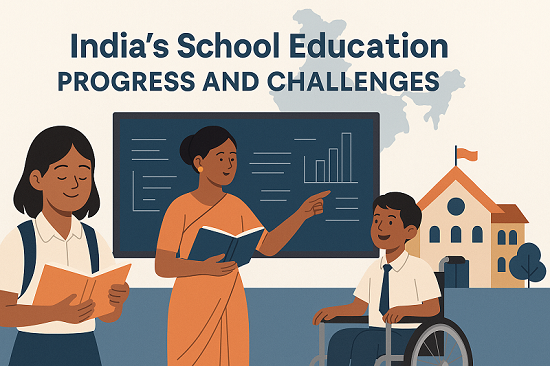
The Ministry of Education’s latest Unified District Information System for Education Plus (UDISE+) 2024–25 report offers an important snapshot of India’s school education. The numbers reveal progress across teachers, enrolments, infrastructure, and gender representation. But as with any large-scale dataset, the fuller story emerges when these achievements are held against persistent challenges on the ground.
Key Improvements Highlighted in the Report
Teachers and Student Ratios
For the first time, India has crossed the one crore mark in the number of teachers. From 94.8 lakh in 2022–23 to over 1.01 crore in 2024–25, the increase represents a 6.7% rise within two years. The Pupil-Teacher Ratio (PTR) too has improved sharply, now standing at 10 for the foundational stage, 13 at the preparatory level, 17 in middle school, and 21 in secondary. All of these are comfortably better than NEP 2020’s recommendation of 30:1, suggesting children now have more access to individual attention.
Dropouts and Retention
Dropout rates have fallen across the board. At the preparatory stage, they are down to 2.3%; in middle school to 3.5%; and in secondary to 8.2%. Retention, meanwhile, has climbed, with 92.4% of students staying on through the preparatory stage, 82.8% at middle, and 47.2% at secondary—supported by the increase in schools offering higher grades.
Transition and Enrolment
More children are continuing their education without breaks. Transition from foundational to preparatory is up to 98.6%, and from middle to secondary to 86.6%. Gross Enrolment Ratio (GER) has also risen, with secondary education seeing an uptick from 66.5% to 68.5%.
Infrastructure Growth
Infrastructure remains a bright spot. Over 93% of schools now have electricity, 99% provide safe drinking water, and 97% are equipped with girls’ toilets. Computer access has grown to 64.7%, internet access to 63.5%, and more than half of schools now have ramps and handrails, improving accessibility.
Gender Representation
Representation of women in teaching has crossed 54%, and girls’ enrolment has edged up to 48.3%, showing slow but steady progress towards gender parity.
Where the Numbers Need Context
While the report reflects genuine gains, the full picture requires a closer look at what these numbers mean in practice.
Teachers: Quantity vs Quality
Crossing the one-crore milestone is historic. Yet reports continue to highlight shortages in subject specialists and concerns about teacher training. A strong student-teacher ratio is valuable only if classrooms are led by well-prepared, motivated educators.
Dropouts: Regional Gaps Persist
The steady fall in dropout rates is promising, but averages mask uneven realities. States like Bihar still struggle with alarming dropout figures, particularly among girls and marginalised communities. National averages hide state-level realities.
Access Without Schools
It is encouraging to see single-teacher and zero-enrolment schools on the decline. However, the deeper problem isn’t just these schools but the absence of schools altogether in thousands of villages. Maharashtra alone has over 8,000 villages without schools. That’s not a statistic you’ll find in the UDISE+ summary, but it matters when we talk about access.
Digital Infrastructure: From Presence to Practice
Computer and internet access are on the rise, yet, other surveys suggest that many of these facilities remain underused, serving as placeholders for inspections rather than as tools for learning. Less than a quarter of India’s 1.47 million schools have smart classrooms. Digital literacy among students and teachers is patchy at best. So while infrastructure is expanding, its integration into actual pedagogy lags far behind.
Inclusion: Beyond Ramps
Ramps and handrails are a welcome start, but inclusion for children with disabilities requires much more. How many schools have accessible toilets, special educators, or learning aids for children with disabilities? And the bigger question: how many children with disabilities are actually enrolled and attending school regularly? Current data rarely tells us this.
Gender: Representation Without Leadership
Girls’ enrolment is up slightly to 48.3%. Female teachers now account for 54.2% of the workforce. Encouraging signs, yes. But leadership remains a male stronghold. Across higher education, only about 9.5% of institutions in India are led by women. At the school level too, women remain underrepresented in principal and leadership roles. Representation in classrooms is improving; representation in decision-making is not.
Reading the Report Holistically
The UDISE+ 2024–25 findings point to a system that is steadily improving access, retention, and infrastructure. But progress cannot be measured in isolation. Numbers must be matched with quality, access must be inclusive, and representation must extend to leadership. A fuller picture of Indian education comes not from rose-tinted fragments but from an honest balance of achievements and unfinished work.
Edutainment
Weaving Social-Emotional Learning into the Curriculum
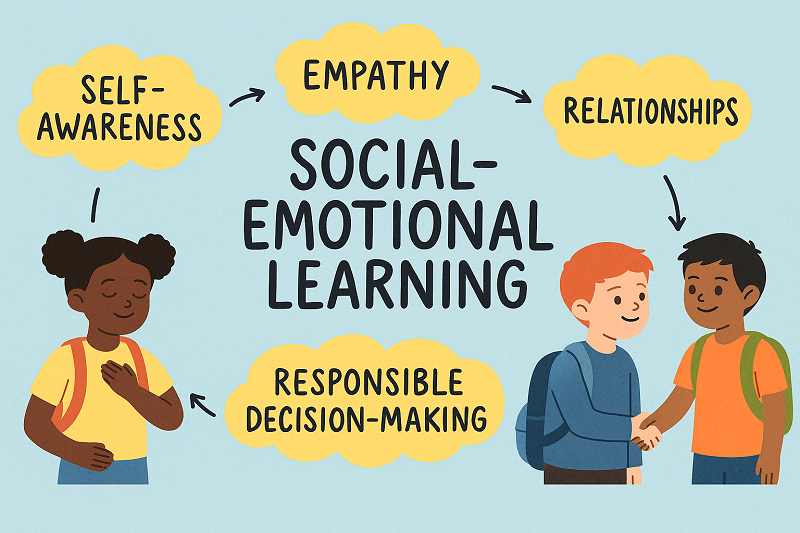
When we think of school learning, the first things that come to mind are math equations, science experiments, history timelines, and grammar rules. But education isn’t only about academic skills—it’s also about preparing students for life. This is where Social-Emotional Learning (SEL) steps in, transforming classrooms into spaces that nurture not just minds, but hearts.
What is Social-Emotional Learning?
Social-Emotional Learning is the process through which students acquire and apply skills to:
- Understand and manage emotions
- Build healthy relationships
- Show empathy for others
- Make responsible decisions
- Set and achieve positive goals
In simpler terms, SEL is about helping students become self-aware, emotionally intelligent, and socially responsible.
Why Should SEL Be Part of the Curriculum?
For decades, education focused on the “3 Rs” – reading, writing, and arithmetic. Today, we know that EQ (Emotional Quotient) can be just as important as IQ. Studies show that integrating SEL into the curriculum leads to:
- Improved academic performance
- Reduced stress and anxiety
- Fewer behavioural issues
- Stronger peer relationships
- Better conflict-resolution skills
A student who learns how to manage frustration or work well in a team is more likely to thrive both inside and outside the classroom.
How SEL Fits into Different Subjects
- Language and Literature – Discussing characters’ feelings in a story builds empathy and perspective-taking.
- Science – Group experiments encourage collaboration and respectful communication.
- Mathematics – Problem-solving in pairs or teams fosters patience and perseverance.
- Social Studies – Exploring diverse cultures promotes acceptance and respect.
Practical Ways to Embed SEL into Curriculum
- Morning check-ins: A quick emotional “temperature check” helps teachers understand students’ moods.
- Role-play activities: Encourage students to act out scenarios that require empathy or problem-solving.
- Collaborative projects: Promote teamwork, negotiation, and leadership skills.
- Mindfulness breaks: Simple breathing exercises can improve focus and emotional balance.
When SEL is woven into lesson plans, we move from an education system that simply imparts knowledge to one that shapes compassionate, resilient, and adaptable individuals. In a world that is constantly changing, these life skills are not optional—they are essential.
Final Sum-Up
Social-Emotional Learning doesn’t replace academic learning; it enriches it. By combining books with empathy, logic with kindness, and grades with grit, we can prepare students not just for exams, but for life.
This article is authored by-

Ranjith P C, Head- Curriculum Excellence, TVS Education
Education
Education with Purpose: Shaping Responsible Learners for a Better Tomorrow

Education is the wellspring of civilization. It begets arts, culture, sciences, and polity to create a society oriented towards discovery and development. Through the ages, education has evolved to meet the needs of the times, and presently, it has reached an inflection point. The inexorable advancement of technology, abundance of information, pressing societal challenges and climate crisis have compelled educators to re-imagine education for the 21st century.
With the rapid prevalence of generative artificial intelligence, the question rightly being asked is: “What should we teach children when almost all answers can be readily had from AI?” The education of tomorrow would reward critical thinking over knowledge. That is what our focus and onus as educators should be. Children, being the digital natives, are more inclined to leverage the full potential of technology. It is up to us to help them realize and understand that AI should augment – not replace – HI (human intelligence). To think critically, to understand, to create and innovate should always be the preserve of humans. The ‘human-first, tech forward’ approach should become the cornerstone of education, going ahead.
An equal focus has to be on building skills, values and attitudes to address the most pressing problems of the world today. The World Economic Forum’s Education 4.0 framework underscores the importance of nurturing global citizenship, environmental stewardship, growth mindset, adaptability, civic responsibility, socio-emotional awareness, empathy, and kindness. The challenge is to find ways to model these into learners’ personality, traits and behaviours.
Re-designing curricula, taking learning beyond classrooms, and reforming assessments could be the answer. Marks and grades can only be one of the benchmarks of learning. Time has come for us to consider skill-based and value-based assessments to reflect a learner’s competence and character. Here, the National Education Policy 2020 – with its progressive vision – can be the guiding compass to steer us towards a more holistic and value-driven paradigm of learning. Institutions should also harness technology to create personalized learning pathways to meet the unique needs of each student.
None of this transformation would be possible without more empowered and enlightened teachers. Progressive institutions are already taking a lead in continuous professional development of their teachers and staff. On their part, teachers will have to be open to unlearn and relearn, upskill and reskill to stay abreast of the new pedagogies and technology. They should be adept in delivering personalized learning using data-driven insights and adapt to the new role of facilitators in an ecosystem where student agency is growing increasingly assertive. Schools must actively engage with parents and students to help them understand the need to look beyond grades. Parents must be informed of the changing jobs market and the importance of building durable skills.
Reforms and initiatives are also required at the policy level to attract private capital into an education landscape where private schools are outnumbered by government schools but cater to about half of the total 24.8 crore school-going student population. The potential of public-private partnerships should also be explored to elevate the quality of education in government schools. Digital infrastructure across the nation has to be strengthened to make learning accessible to the last child in the remotest of places. Creation and dissemination of multi-lingual content will enhance inclusivity of learning in the new Bharat.
Today, the education fraternity, governments, and parents need to collaborate to facilitate this transition into Education 4.0. We need to re-envision education as a human development endeavor to create a sustainable future wherein prosperity goes hand-in-hand with people and the planet. Right intentions need to be followed with earnest action. The future will be India’s to claim.
This article is authored by-

Shishir Jaipuria, Chairman, Seth Anandram Jaipuria Group of Educational Institutions
Education
Empathy as a 21st-Century Competency: Developing Emotional Intelligence among Students
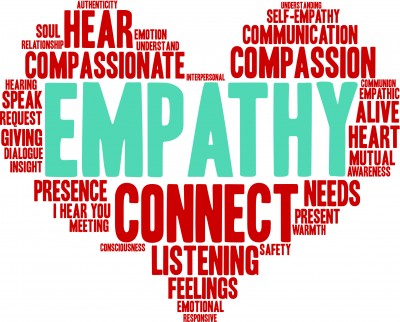
Within the conversation of future-ready education, empathy has moved from being characterized as a “soft” individual characteristic to being identified as an essential social and cognitive ability. Frameworks such as the OECD Learning Compass 2030, UNESCO’s Global Citizenship Education, and the World Economic Forum’s Future of Jobs Report put empathy at the forefront of skills required to succeed in an uncertain, interdependent world.
From Emotion to Competence
Empathy is confused with sympathy, yet they are essentially different. Empathy is an active, cognitive, and affective process, the capacity to grasp another’s emotional situation, comprehend it in context, and react creatively. Neuroscientific research, for example, by Decety and Jackson (2004), illustrates that empathy engages both the limbic system, which controls emotional resonance, and the prefrontal cortex, which controls perspective-taking and rational reaction. Briefly put, empathy does not just mean “feeling with someone”, it means thinking with feeling, where intellect and emotion unite to shape behaviour and decision-making.
Early Childhood (Ages 3–6) – Seeds of Empathy
At the age of three to six years, children in early childhood start showing the beginning signs of empathy by what is termed as “emotional contagion” by psychologists. They tend to cry when others cry or smile when others smile due to the observed emotional state. By the time they are four or five years old, according to research conducted by Zahn-Waxler et al. (1992), children start showing other-oriented concern like sharing, comforting, or embracing a fellow child who looks distressed. Empathy at this age is still primarily affect-based; children sympathize with others but possess little ability to grasp intricate frames of mind. Teachers can cultivate these early roots of empathy through narrative, role-playing, and guided social-emotional education that offer the vocabulary and structure to make sense of emotions.
Middle Childhood (Ages 7–12) – Perspective-Taking Develops
By middle childhood, around ages seven to twelve, empathy is increasingly cognitively complex. They start to understand that people might think and feel differently from themselves, an ability outlined in Selman’s stages of perspective-taking. Peer relationships are increasingly important at this stage, and children increasingly become sensitive to fairness, belonging, and group membership. According to research by Eisenberg et al. (2010), this is a critical window for the instruction of moral reasoning in addition to empathy. Cooperative learning activities, peer mediation programs, and community service offer children meaningful opportunities for empathy extension from intimate friendships to include strangers and even members of out-groups.
Adolescence (Ages 13–18) – Abstract and Global Empathy
An important stage in the development of empathy is adolescence, which lasts from the ages of thirteen to eighteen. Adolescents gain the ability to relate to abstract ideas such as global emergencies, injustice, and inequality. According to Blakemore’s (2018) neuroimaging research, adolescent brain regions involved in identity formation and social cognition are more active. However, hormonal changes and heightened self-awareness are also hallmarks of adolescence, which makes young people more reflective. Schools can assist in this area by offering intentional opportunities for teenagers to develop empathy, such as discussion forums that foster critical thinking, service-learning initiatives that are linked to current events, and cross-cultural interactions that extend their horizons. Adolescents can use these activities to channel their growing empathy into constructive civic engagement.
Young Adulthood (18+) – Empathy as Leadership Skill
Empathy matures during late adolescence and young adulthood as a skill that is intricately linked with emotional control, leadership, and ethical choice. Now, it transcends interpersonal interaction to become the hallmark of effective leadership. More employers are realizing this; a 2022 LinkedIn survey indicated that 78 percent of employers view emotional intelligence as equally or even more important than technical skills. Universities and workplaces increasingly require such competencies, and schools can prepare young adults through leadership programs, mentorship positions, and reflective practices that instil empathy in civic and professional life.
Beyond Awareness to Application
While awareness of empathy is valuable, its real utility comes from practice. Schools need to inculcate empathy not only in coursework but in lived experience. Narrative immersion in literature, film, and even virtual reality allows students to step into other people’s shoes. Structured ethical discussions in dialogic classrooms offer the space for respectful disagreement and deeper understanding. Cross-age mentorship, where older students mentor younger ones, develops a sense of responsibility while strengthening bonds across age. Service-learning, when paired with structured reflection, develops empathy into action. Even cutting-edge tools that offer emotional analytics while working in a team can assist students in self-evaluating and managing their emotions, turning empathy into a mindful and deliberate process instead of an automatic reaction.
The 21st-Century Payoff
The dividend of developing empathy in education is significant. In a world of artificial intelligence, empathy is one differentiator that makes us uniquely human. The World Economic Forum (2025) identifies emotional intelligence, empathy, and collaboration as among the future workforce’s top ten skills. Students who can read emotional team dynamics, negotiate across cultures, and build authentic relationships are not just more hireable but indeed invaluable in a fast-paced professional landscape.
Empathy is not a mushy virtue but a developmental skill that develops systematically throughout childhood and adolescence. Schools that deliberately foster it are not just creating smarter students; they are raising wiser, kinder citizens who can lead with compassion and resilience. Empathy is a moral and practical necessity for 21st-century education, the bridge that unites emotional intelligence and the needs of an interconnected world.
(This article is authored by Dr. Silpi Sahoo, Chairperson, SAI International Education Group)
-
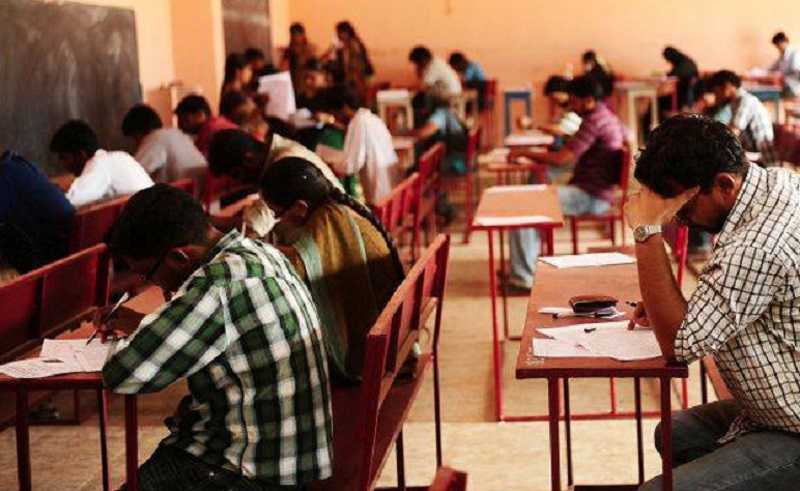
 Education3 months ago
Education3 months agoNational Task Force Calls for Wider Participation in Surveys on Student Well-being and Suicide Prevention
-

 Education3 months ago
Education3 months agoUK and US Tighten Student Visas: What Indian Schools and Students Must Know
-

 Education3 months ago
Education3 months agoWhat Nepal’s Gen Z Protests Teach Us About Education, Civic Sense, and Media Literacy
-

 Education3 months ago
Education3 months agoKidspreneurship Appoints Kushark Jaiswal as Chief Global Officer to Drive International Expansion
-

 Education3 months ago
Education3 months agoParliamentary Panel Calls for Media Literacy Curriculum in Schools
-
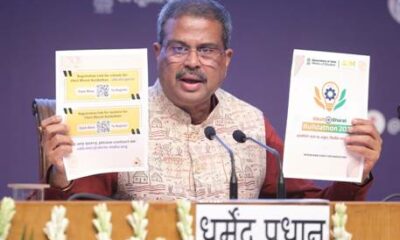
 Education3 months ago
Education3 months agoMinistry of Education launches Viksit Bharat Buildathon 2025 to Ignite Innovation among School Students
-

 Education3 months ago
Education3 months agoMaharashtra Education Department Plans Students’ Tour to NASA
-

 Education3 months ago
Education3 months agoGovernment Plans to Introduce Skill-Based Learning in Class 11 and 12 Curriculum
-
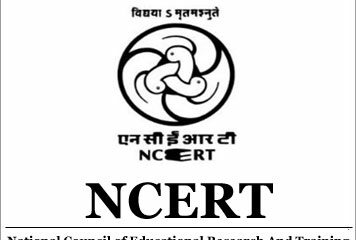
 Education3 months ago
Education3 months agoNCERT to Grant Equivalence to Class 10 and 12 Certificates Across Boards for Admissions and Jobs
-

 Education3 months ago
Education3 months agoClass 11 Student Navya Mrig on a Mission to Bust Myths About Organ Donation







